The New NVIDIA Quadro FX Series
Covering the Price/Performance SpectrumNVIDIA unveils seven new PCI Express graphics accelerators offering great 3D performance at every price range.
December 4, 2001
By David Cohn
NVIDIA has been rolling out new PCI Express-based graphics accelerators ever since introducing its first Quadro FX boards nearly two years ago. This time, the company has refreshed its entire product line from the bottom to the top, and even introduced a new ultra high-end board featuring 1GB of video memory.
While DE has been fortunate enough in the past to review many of the new boards in the NVIDIA Quadro FX family, this time we received all six of the new boards the company recently introduced, as well as another ultra-high-end board unveiled late last year.
All of NVIDIA’s Quadro graphics accelerators feature a true 128-bit precision graphics pipeline, with 32 bits of floating-point precision per RGB component, to deliver millions of color variations. They also support 12-bit subpixel precision, yielding high geometric accuracy. According to the company, its new rotated grid antialiasing algorithm results in drastic improvements in the image quality of antialiased images.
New Family Members
The NVIDIA Quadro FX 350 ($199 MSRP/$175 average street price) is the company’s new low-end entry-level card. The board comes with 128MB of DDR2 video memory with a 64-bit memory interface, yielding a memory bandwidth of 6.48GBps. The board delivers 55 million triangles per second and 2 billion texels per second and comes with one DVI-I connector and one analog VGA connector. This particular board is available only through NVIDIA’s sales channels.
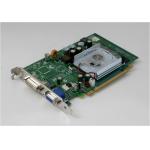 |
| The NVIDIA Quadro FX 350. |
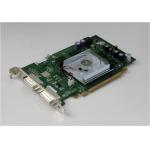 |
| The NVIDIA Quadro FX 550. |
On the left, the low-end entry-level NVIDIA Quadro FX 350 is available only through NVIDIA’s sales channel. On the right, the mid-entry-level NVIDIA Quadro FX 550. (Photo by David Cohn.) Click images to enlarge.
Up a step, and available through both OEMs and the normal NVIDIA channel, is the Quadro FX 550 ($279 MSRP/$197 street). With 128MB of GDDR3 memory and a 128-bit memory interface, the board provides a nice jump in performance for a modest increase in cost. The card’s graphics processing unit (GPU) has a memory bandwidth of 19.2GBps. This board offers two DVI-I connectors.
The third entry-level board in the NVIDIA lineup is the Quadro FX 560 ($299 MSRP/ $234 street). Although populated with 128MB of GDDR3 memory equal to its lower-cost sibling, its more advanced GPU has a 19.2GBps memory bandwidth and pumps out 140 million triangles and 2.8 billion texels per second. In addition, one of the board’s two DVI connectors supports dual link, enabling the board to support ultra-high resolution displays such as the 30-inch Apple Cinema Display, which has a resolution of 2560 x 1600. At a refresh rate of 25Hz, dual-link output is actually capable of resolutions up to 3840 x 2400. The FX 560 also supports high-definition component video output.
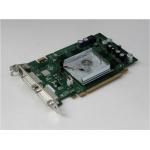 |
| The NVIDIA Quadro FX 560. |
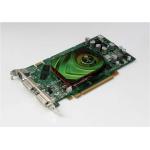 |
| The NVIDIA Quadro FX 1500. |
On the left, the other new entry-level NVIDIA board, the Quadro FX 560. On the right is the mid-range NVIDIA Quadro FX 1500. (Photos by David Cohn.) Click images to enlarge.
For the mid-range, NVIDIA introduced the new Quadro FX 1500 ($699 MSRP/$490 street). This board doubles the amount of GDDR3 memory to 256MB and ups the memory interface to 256-bit, helping boost bandwidth to 40GBps. This is the true sweet spot for mainstream MCAD, and the FX 1500 really delivers. Throughput is rated at 144 million triangles and 6.0 billion texels per second. The FX 1500 also includes dual link support on both DVI-I ports.
The new Quadro FX 3500 ($1,599 MSRP/$928 street) is NVIDIA’s new high-end graphics accelerator. The board comes with 256MB of GDDR3 memory with a 256-bit memory controller, yielding a memory bandwidth of 41.6GBps. The GPU delivers 174 million triangles and 9.4 billion texels per second. In addition to its two dual-link DVI-I connectors, the board also supports stereoscopic 3D output as well as NVIDIA’s Scalable Link Interface (SLI). SLI technology enables two NVIDIA Quadro FX graphics boards to work in tandem to increase the graphics performance of a single workstation (assuming the computer system will support two PCI Express graphics boards). The FX 3500 requires an auxiliary connection to the system power supply.
The NVIDIA Quadro FX 4500 ($2,299 MSRP/$1,623 street) is technically not a new board. This ultra-high-end graphics accelerator was introduced last fall, but since we had not previously had a chance to review this board, NVIDIA sent it to us along with the other newly introduced boards.
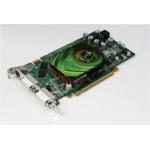 |
| The NVIDIA Quadro FX 3500. |
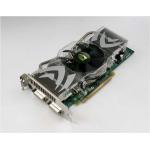 |
| The NVIDIA Quadro FX 4500. |
On the left, the new high-end NVIDIA Quadro FX 3500. On the right is the ultra high-end NVIDIA Quadro FX 4500. Click images to enlarge. (Photo by David Cohn.)
The FX 4500 comes with 512MB of GDDR3 memory with a 256-bit memory interface. Its memory bandwidth is rated at 41.6GBps, the same as the FX 3500, but the GPU in the FX 4500 delivers 181 million triangles and 10.8 billion texels per second. Like the FX 3500, both DVI-I connectors support dual link and the board offers a stereo 3D connector and SLI support. The FX4500 also requires extra power, and the board’s large cooling fan protrudes more than an inch from the board, making it impossible to utilize the adjacent expansion slot. NVIDIA offers an optional Genlock/Framelock G-Sync option board for the FX 4500.
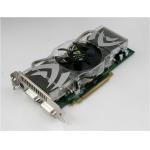 |
| The NVIDIA Quadro FX 5500. |
› › The new ultra high-end NVIDIA Quadro FX 5500 comes with 1GB of video memory. (Photo by David Cohn.)
At the extreme top end, NVIDIA introduced the FX 5500 ($2,999 MSRP/$2,573 street), an ultra-high-end graphics accelerator equipped with 1GB of GDDR2 memory. The slightly slower memory results in a memory bandwidth of 33.6GBps, but the combination of double the memory plus its advanced GPU enables the FX 5500 to pump out 235 million triangles and 15.6 billion texels per second. Like the FX 4500, the FX 5500 provides two dual-link-enabled DVI-I connectors, SLI capability, stereo 3D support, and the available G-Sync option board. Again, this large board extends into the adjacent expansion slot.
Benchmarking the Boards
We tested all seven boards using the same 3.4GHz HP xw4200 workstation that we’ve used for all of our previous PCI Express-based boards, so all results are directly comparable. To judge performance, we ran version 8.1 of the SPECviewperf benchmark. (You access an Excel file of the benchamark results by clicking here.) For a comparison, we list results for the same tests performed on last year’s boards.
All of the new NVIDIA boards clearly outperformed the company’s previous generation of graphics accelerators in each product range—entry level, mid-range, and high-end. And the FX 5500, FX 4500, and FX 3500 even outperformed the 3DLabs Wildcat Realizm 800—the former ultra high-end champ—on four of the eight SPEC viewperf tests.
All of the new NVIDIA Quadro FX boards are fully certified with most MCAD and DCC (digital content creation) applications (except for the FX 5500, which was going through driver certification at the time of our review). All of the boards in the NVIDIA Quadro FX line use the same unified video driver architecture, including the earlier boards. Drivers are available for Windows XP, Windows XP64, Windows 2000, and Windows NT as well as Linux 32 and Linux 64.
NVIDIA has discontinued some of its earlier Quadro FX boards as they’ve been replaced by newer, better performing products at similar price points. Some of those earlier boards may still be available, but with the improved performance of these new boards, we recommend going with the newer products. With seven to choose from, there’s certainly a high-performing NVIDIA Quadro FX graphics accelerator available for every MCAD/CAE user.
David Cohn is a computer consultant and technical writer based in Bellingham, WA. He’s a Contributing Editor to Desktop Engineering, the Editor-in-Chief of Engineering Automation Report and CADCAMNet published by Cyon Research, and the author of more than a dozen books. You can contact David through his website or click here to send him an e-mail about this article.
NVIDIA Quadro FX Series
NVIDIA Corp.
Santa Clara, CA
Requirements
PCI Express-based workstation with available x16 lane graphics slot; Microsoft Windows XP, Windows XP 64-bit Edition, Windows 2000, Windows NT (SP6), Linux
Pricing
NVIDIA Quadro FX 350 — $199 (MSRP), $175 (average street)
NVIDIA Quadro FX 3550 — $279 (MSRP), $197 (average street)
NVIDIA Quadro FX 560 — $299 (MSRP), $234 (average street)
NVIDIA Quadro FX 1500 — $699 (MSRP), $490 (average street)
NVIDIA Quadro FX 3500 — $1,599 (MSRP), $928 (average street)
NVIDIA Quadro FX 4500 — $2,299 (MSRP), $1,623 (average street)
NVIDIA Quadro FX 5500 — $2,999 (MSRP), $2,573 (average street)
Subscribe to our FREE magazine, FREE email newsletters or both!
About the Author
David Cohn is a consultant and technical writer based in Bellingham, WA, and has been benchmarking PCs since 1984. He is a Contributing Editor to Digital Engineering, the former senior content manager at 4D Technologies, and the author of more than a dozen books. Email at [email protected] or visit his website at www.dscohn.com.
Follow DE





